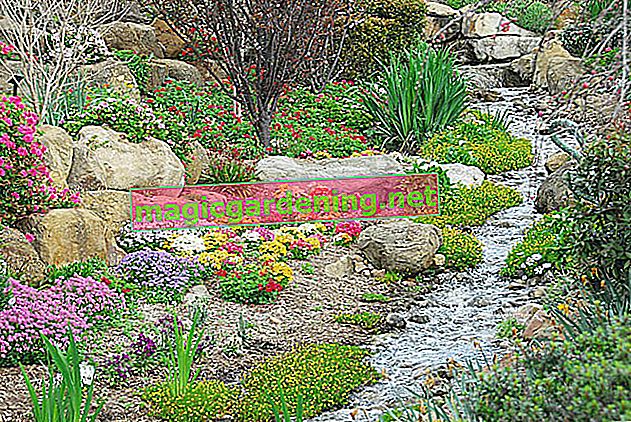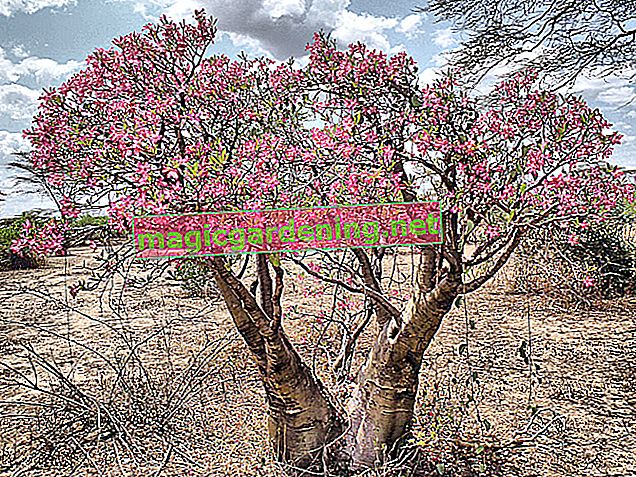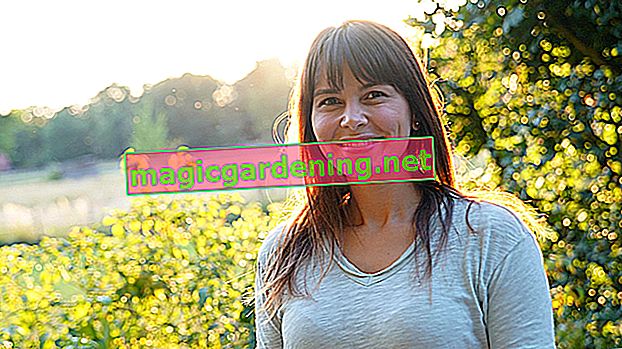
Origin and Distribution
The different forms of the hybrid moss saxifrage (bot. Saxifraga x arendsii) do not always have the same parent species, so that a specific assignment cannot be made. Strictly speaking, it is not a species term, but a collective term for different varieties of the garden saxifrage. Gardeners divide the numerous breeds into sections to make it easier to differentiate, whereby species such as the astmoss saxifrage (bot. Saxifraga hypnoides) and the turf saxifrage (bot. Saxifraga rosacea) are probably the parent species of most cultivated forms.
also read
- The moss saxifrage: hardy or in need of protection?
- Plant the saxifrage properly in the garden
- Proper care for the saxifrage
Incidentally, the botanical name Saxifraga x arendsii pays homage to the famous German gardener and plant breeder Georg Arends, in whose nursery the first hybrid saxifrage varieties were created.
use
Moss saxifrage belongs to classic rock garden planting and is a must in practically every stone bed. In addition, the undemanding perennial is very suitable for greening bare dry stone walls. Although the plant thrives best in light locations, it is considered to be well tolerated by shade and can therefore also be planted in partially shaded to shady beds as a foreground or border. The herbaceous plant looks very pretty, for example as an underplanting of deciduous trees and cleverly conceals bald spots. Saxifraga x arendsii are also very suitable as grave plants. Moss saxifrage can be combined particularly well with various ferns and shadow grasses, but also with perennials such as bleeding heart (Lamprocapnos spectabilis), elven flowers (Epimedium), cranesbills (Geranium), carnations (Armeria), purple bells (Heuchera),Bergenia (Bergenia), Columbine (Aquilegia) or flowers of the gods (Dodecatheon) combine.
Appearance and stature
Depending on the variety, the moss saxifrage, which can reach heights of up to 15 or 20 centimeters, forms evergreen leaf rosettes, which over time can develop into dense cushions through side shoots and runners.
leaves
The leaf rosettes consist of up to five centimeters long, rather thick leaves that have a dull pale green color and are pinnate.
Blossoms and flowering period
From the flat leaf rosettes, the significantly higher flower stems grow in spring, on which there are many small, cup-shaped flowers. These can appear in a wide variety of colors depending on the variety. For example, there are white, yellow, purple, pink or deep red varieties. However, varieties with changing flower colors that can fade or darken over time are particularly interesting.
The main flowering time of the Saxifraga x arendsii hybrids falls in the months May to June, whereby some varieties can bloom significantly earlier if the weather allows. After flowering, capsule fruits are formed.
Location and soil
The different Saxifraga arendsii hybrids have quite different demands on the location. Basically, almost all varieties thrive in partial shade to shade, although some varieties require more light than others. Basically, however, you can't go wrong with a bright but sunny location. Much more important is the soil, which has a high permeability and has to be fresh rather than dry. The perennial feels most comfortable in humus rich, nutrient-rich soils, which are particularly preferable because moss saxifrage is difficult to fertilize due to its often low height. However, the plant also thrives very well in poor soil, but is then dependent on a regular supply of nutrients.
Plant moss saxifrage properly
Plant the moss saxifrage plants in the bed between spring and autumn at intervals of 20 to 30 centimeters, whereby the recommended planting distance depends heavily on the selected variety. It is therefore imperative that you follow the instructions on the plant label. Before planting, work ripe compost or well-rotted manure into the ground and submerge the root ball in a bucket of water before planting. In this way, the roots can soak up moisture again and then grow on more easily.
By the way, specimens planted in spring do not bloom until the following year, which is why autumn planting is preferable for rapid bloom. The cushion-like growth also only sets in a few months later.
Pour moss saxifrice
Most Saxifraga arendsii hybrids prefer fresh soil, which is why you should water regularly, especially in longer dry periods. Always water the plants from below, never over the leaves. The water can accumulate in the rosettes, which in turn leads to rot and fungal diseases. For the same reason, a permanently damp surface or even waterlogging must be avoided. During planting, it makes sense to mulch the area with bark mulch, gravel or the like so that the soil does not dry out too quickly and you have to water less.
If the moss saxifrage leaves its leaves hanging, it usually needs water. Healthy plants recover quickly after watering and are not damaged.
Fertilize moss saxifrage properly
Basically you only have to fertilize Saxifraga arendsii hybrids in very poor locations or when there are deficiency symptoms. To do this, spread some compost among the plants and work it lightly - and carefully so as not to damage the roots - into the soil.
Cut moss saxifrice properly
Regular pruning is not necessary, but dead leaf rosettes and faded stems should be removed promptly.
Propagate moss saxifrage
The various hybrids of the moss saxifrage can be easily reproduced either by dividing them or by rooting cuttings. Since Saxifraga x arendsii only very rarely develops fruits and thus seeds, propagation via seeds is basically possible, but is rarely used.
division
In any case, the plants should be dug up at intervals of two to three years, divided and planted separately from each other in a new location - namely, moss saxifrage has a habit of developing loose growth over time and thus getting holes in the cushion. The regular division gives you the compact and dense growth. And that's how it works:
- Carefully dig up the plants.
- Gently shake off any clinging earth.
- Carefully tear or cut the plants together with the root ball.
- Cut away diseased plant parts and bald spots.
- Put the individual plants in a new location or in fresh substrate.
- Water the planting vigorously to encourage new root formation.
Cuttings
When propagating cuttings, take young shoots from the cushion edges in early summer and plant them either in the bed or first in a pot with potting soil. Some of these cuttings are already rooted, as the moss saxifrage reproduces itself through runners. Incidentally, with the help of cuttings, bald spots can be covered very well by placing the plants on them. The cuttings grow well within a few weeks and close the gaps in the cushion.
Overwinter
Moss saxifrage is very hardy and only needs light winter protection if it is freshly planted young plants or specimens cultivated in pots. In addition, freezing temperatures - i.e. low temperatures below zero without a protective blanket of snow - can also become a problem, which is why you should cover the plants with brushwood or leaves in the cases mentioned. Remove the cover in good time in spring so that the perennials can sprout again. However, watch out for late frosts and protect the plants from them if necessary.
Tips
Moss saxifrage is very robust and is rarely attacked by diseases or pests. Only rosette rot, caused for example by excessive moisture, can become a problem. In this case, you should cut out diseased parts of the plant and ensure more dryness.
Species and varieties
There are around 480 different saxifrage species, some of which are difficult to distinguish from one another. The moss saxifrage (bot. Saxifraga x arendsii), which grows only about ten to 20 centimeters high, is wonderfully suitable for planting rock gardens, but can also be settled in crevices or on dry stone walls. Here the low perennial shows its decorative flowers, depending on the species and variety in spring between March and April or in late summer between August and October. There is a large selection of varieties in different flower colors. For the ornamental and front garden, for example, these are very suitable:
- 'Carpet of flowers': up to 20 centimeters in height, carmine-pink flowers between March and April
- 'Bob Hawkens': up to 15 centimeters tall, pink flowers between May and June
- 'Sleeping Beauty': up to 15 centimeters in height, light red flowers between May and June
- 'Spring snow': up to 25 centimeters in height, pure white flowers between May and June
- 'Ingeborg': up to 15 centimeters in height, dark red flowers between May and June
- 'Peter Pan': Up to 15 centimeters in height, carmine-red flowers between March and April
- 'Purpurmantel': Growth height up to 15 centimeters, purple flowers between April and May
- 'Rosenzwerg': up to 20 centimeters in height, purple-pink flowers between April and May
- 'Snow carpet': up to 40 centimeters in height, pure white flowers between March and April
- 'White Pixie': Height up to 20 centimeters, white flowers between April and May
Moss saxifrage, Saxifraga bryoides
In addition, the species Saxifraga bryoides, native to the Pyrenees and other European mountains, is also known as the moss saxifrage. This perennial, which also forms cushion, is very similar to Saxifraga x arendsii, but usually remains smaller with heights of up to ten centimeters. This species also only blooms between July and August and therefore much later.
Alternatives / Similar types
Species planted in gardens are also very similar to the moss saxifrage, such as the garden saxifrage (bot. Saxifraga cortusifolia) or the shrub saxifrage (bot. Saxifraga cotyledon). In contrast to the moss saxifrage, the garden saxifrage can also thrive in partially shaded to shady locations, and it only blooms in autumn between September and October. The shrub saxifrage, on the other hand, needs a sunny spot, but only blooms between June and July.








